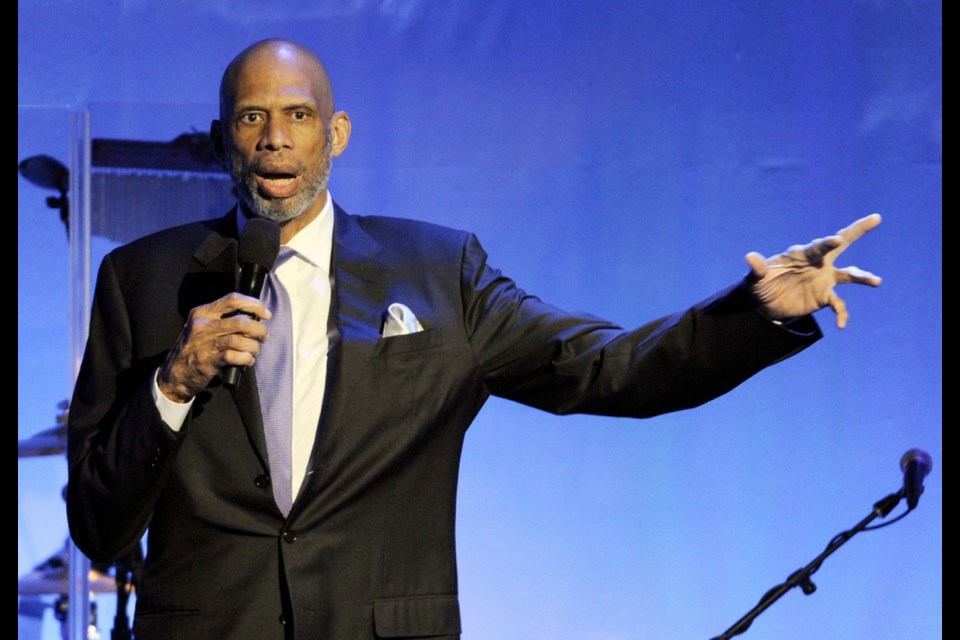Becoming Kareem: Growing Up On and Off the Court
By Kareem Abdul-Jabbar and Raymond Obstfeld
Little, Brown, 304 pp., $23.49
The day after leading the Milwaukee Bucks to their only NBA championship, a young NBA star surprised sports fandom by announcing his conversion to Islam.
On that day in 1971, the former Lew Alcindor became Kareem Abdul-Jabbar. But his conversion and name change began years earlier, he reveals in Becoming Kareem: Growing Up on and Off the Court, a memoir for readers 10 and older, written with his frequent collaborator Raymond Obstfeld. He discusses racism, religion and controversial subjects straightforwardly.
Becoming Kareem covers his life from boyhood in New York to his conversion announcement. It does not stint on basketball: Readers learn how Abdul-Jabbar developed his signature shot, the skyhook. It also speaks directly about athletes and social activism, which Colin Kaepernick can tell you is still a contentious subject today.
Born in 1947 in New York, young Kareem was a shy only child who liked to read, fascinated by cowboys and history. He first preferred playing baseball before gravitating to basketball. As a boy in a multiracial housing project, he writes that he didn’t realize he was black until he saw his own face in a third-grade photo.
While Kareem was growing into and learning to master a body that became 7 feet 2 inches tall, he was also searching for an authentic black identity. He attended Catholic elementary school and Sunday Mass, but the sound of Irish Catholic kids calling him the n-word was a factor in him turning away from that church. “One question that bothered me was how so many people could claim to be devout Christians, yet still justify the brutality they committed against black people,” he writes.
In high school, his respected coach shocked him at halftime after a lacklustre performance by accusing him of acting just like the n-word. Hurt by this breach of respect, Kareem never completely trusted that coach again, though he does write about their reconciliation decades later.
In contrast, he writes warmly about John Wooden, his UCLA coach, whom he considers a second father.
Kareem’s school and university years overlap the civil rights movement of the 1960s. He admired both Martin Luther King Jr. and Malcolm X; like many Americans of his time, he read The Autobiography of Malcolm X, a book that played a role in his conversion. “I was rejecting the religion that was foreign to my black African culture and embracing one that was part of my racial heritage,” Abdul-Jabbar writes. He also explained to fans that he wasn’t joining the Nation of Islam, whose tenets he rejected, but the Sunni branch of Islam.
The young basketball star also looked up to the boxing champion who changed his name from Cassius Clay to Muhammad Ali. Football great Jim Brown invited Kareem to the Cleveland summit in 1967, where black athletes and activists, some of them military veterans, vigorously debated whether to support Ali’s refusal to be drafted into military service. After heated discussion, they did.
Kareem found other mentors, too. He writes gratefully, and with some bemusement, about Wilt Chamberlain, who invited the high schooler to hang out in jazz clubs with him and his entourage. As a UCLA junior, Kareem studied martial arts with Bruce Lee before Lee became an international star. He took to Lee’s personal warmth and flexible philosophy: “The fighter must constantly adapt, using multiple techniques and approaches.” Both Wooden and Lee emphasized preparation and repeated practice of fundamentals, Kareem notes.
He recaps his decision to sign with the Milwaukee Bucks rather than the ABA’s New York Nets, in his hometown, after the ABA delegation low-balled its financial offer. While Abdul-Jabbar would eventually ask for a trade to a city that would better suit his lifestyle as a black, Muslim man with a passion for jazz, he writes graciously about Milwaukee fans and his fellow players there.



